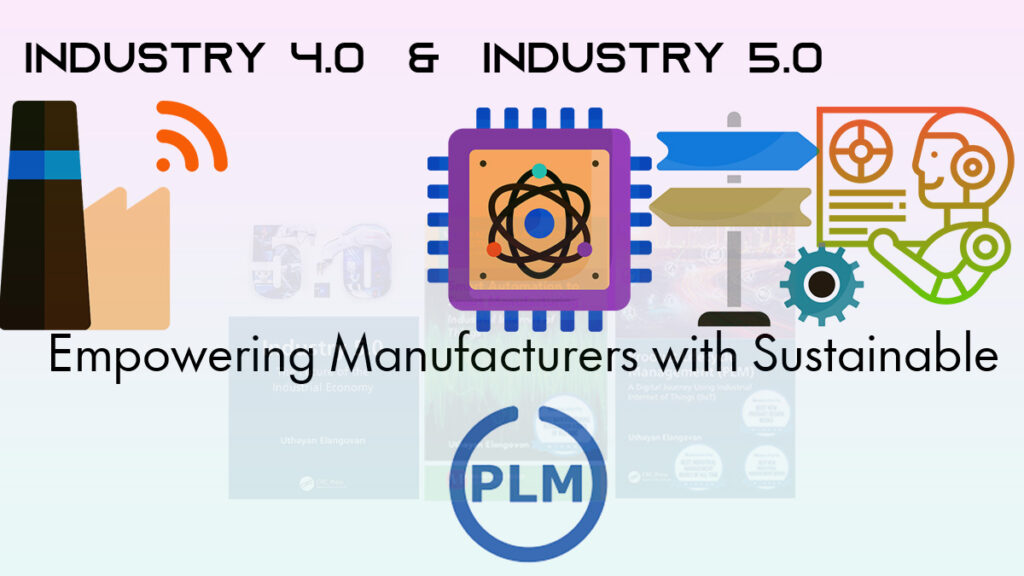Sustaining Success: Embracing Industry 4.0 and Industry 5.0 with PLM. Seamlessly navigate the future of manufacturing with purpose and innovation.

Introduction to PLM:
PLM (Product Lifecycle Management) is a strategic approach to managing the entire lifecycle of a product, from its inception and design through manufacturing, distribution, and disposal. PLM encompasses the integration of people, processes, business systems, and information to streamline product development, optimize resource allocation, and enhance collaboration across the organization. In today’s dynamic business environment, where Industry 4.0 and the emergence of Industry 5.0 are reshaping the manufacturing landscape, implementing an effective PLM system has become crucial for sustainable growth and addressing Environmental, Social, and Governance (ESG) concerns.
Understanding Industry 4.0 and Industry 5.0:
Industry 4.0 heralds the fourth industrial revolution, seamlessly intertwining digital technologies into the very fabric of manufacturing processes. It involves the interconnection of machines, data exchange, and advanced analytics to create a smart, interconnected ecosystem known as the Industrial Internet of Things (IIoT). The rapid advancement in AI, robotics, ML, data analytics, and related fields is giving rise to the fifth industrial revolution, also known as Industry 5.0. This transformative era is primarily driven by AI, with the potential to unlock various other innovations, including quantum computing. By seamlessly integrating people, processes, machines, and the environment, Industry 5.0 promises to revolutionize the way we work and live.
PLM Modules and Their Significance:
- Idea and Concept Management:
This module focuses on capturing and evaluating product ideas, conducting feasibility studies, and identifying market needs. For example, a manufacturing company may use customer feedback and market research to conceptualize a new eco-friendly product in response to the growing demand for sustainable alternatives. - Product Design and Development:
In this stage, the product’s design is created and refined, considering factors like functionality, aesthetics, and manufacturability. PLM software facilitates real-time collaboration among cross-functional teams, enabling seamless communication between designers, engineers, and suppliers. For instance, an automotive company can employ virtual prototyping to optimize the design of an electric vehicle, reducing material waste and energy consumption. - Bill of Materials (BOM) Management:
The BOM module centralizes the list of components required for product assembly. With PLM, manufacturers can track changes, manage suppliers, and ensure compliance with environmental regulations. For example, a furniture manufacturer may use PLM to source sustainable materials and components for its eco-friendly product line. - Manufacturing Process Planning:
This module focuses on optimizing the production process, ensuring efficiency, quality, and resource optimization. PLM software enables simulation and modeling to identify and rectify potential bottlenecks or environmental impacts. In a steel manufacturing plant, PLM can help reduce energy consumption by optimizing furnace operations and recycling scrap metal. - Quality Assurance and Testing:
PLM ensures product quality by facilitating rigorous testing, tracking defects, and implementing corrective actions. For instance, a smartphone manufacturer can employ PLM to run simulations and tests on device durability and energy consumption, thus reducing the environmental impact of excessive returns and replacements. - Supply Chain Management:
With PLM, manufacturers can manage the entire supply chain, track inventory levels, and assess the sustainability performance of suppliers. For example, a clothing company may collaborate with suppliers who comply with fair labor practices and use eco-friendly textiles. - Distribution and Service:
PLM helps streamline logistics and after-sales service processes, ensuring timely delivery and efficient customer support. For instance, a home appliance manufacturer can leverage PLM data to optimize delivery routes, reducing fuel consumption and emissions. - End-of-Life Product Management:
This module focuses on sustainable product disposal, recycling, or repurposing. PLM aids in tracking products at the end of their lifecycle and promoting circular economy initiatives. For example, an electronics company can implement a take-back program to recycle old devices and extract valuable materials for reuse.
Implications in the Era of I 4.0 & 5.0:
- Accelerating Innovation and Time-to-Market:
PLM empowers manufacturers to leverage digital technologies and collaborative platforms, accelerating product development and reducing time-to-market. In the context of Industry 4.0 and Industry 5.0, rapid innovation allows companies to respond swiftly to changing market demands and incorporate sustainable practices. - Enhancing Data-Driven Decision-Making:
PLM systems generate vast amounts of data throughout the product lifecycle. Leveraging data analytics and AI, manufacturers can make informed decisions regarding resource optimization, energy efficiency, and environmental impact. For instance, an automotive manufacturer can analyze data from sensors embedded in vehicles to optimize driving patterns, reducing fuel consumption and emissions. - Fostering Human-Machine Collaboration:
With Industry 4.0 and Industry 5.0, humans and machines collaborate more closely, leading to improved production efficiency and quality. PLM facilitates this collaboration by providing a seamless interface between human workers and smart technologies, allowing manufacturers to combine human creativity and problem-solving skills with AI-driven insights to address sustainability challenges. - Meeting ESG Goals:
PLM emerges as the linchpin empowering manufacturers to achieve their Environmental, Social, and Governance goals with precision and purpose. By promoting sustainable design, resource efficiency, ethical sourcing, and circular economy practices, PLM aligns with the broader objectives of ESG reporting and sustainable development.
Conclusion:
In the era of Industry 4.0 and Industry 5.0, Product Lifecycle Management emerges as a critical tool for manufacturers seeking sustainable growth and innovation. By harnessing the power of digital technologies, AI-driven analytics, and collaborative platforms, PLM enables manufacturers to navigate the complexities of the modern manufacturing landscape while addressing environmental, social, and governance concerns. As industries evolve, embracing Industry 4.0 and Industry 5.0 with PLM not only ensures better decision-making but also contributes to a greener, more responsible, and prosperous future.

